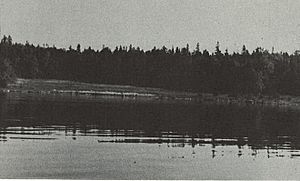Mero Site facts for kids
Quick facts for kids Mero Site |
|
|---|---|

View of Mero Site
|
|
| Location | on the Door Peninsula in Door County, Wisconsin |
| Lua error in Module:Location_map at line 420: attempt to index field 'wikibase' (a nil value). | |
The Mero Site is an important archaeological spot in Door County, Wisconsin, United States. It's on the Door Peninsula. This site is like a layered cake of history, showing many different groups of people who lived there long ago.
Archaeologists dug up the Mero Site in 1960. Ronald and Carol Mason led this work. They were from the Neville Public Museum in Green Bay, Wisconsin. Peter Mero, who owned the land, helped pay for the dig.
Contents
What Makes the Mero Site Special?
The Mero Site is special because it shows a very long history. People lived there for almost 2,000 years! This was from about 500 B.C. to A.D. 1400.
A Journey Through Time
Archaeologists study the layers of soil and artifacts to understand the past. At the Mero Site, they found different types of pottery. These pottery styles show how cultures changed over time.
- Early Cultures: The oldest pottery belongs to the Middle Woodland North Bay culture.
- Later Changes: Over time, this culture slowly changed into the Late Woodland Heins Creek culture. This change happened right there at the site.
- New Arrivals: After A.D. 1000, a new group arrived. They were part of the Upper Mississippian culture, known as Oneota. Their pottery was different from what was there before.
The Unique Oneota People at Mero
The Oneota people who lived at the Mero Site are quite unique. Their group is sometimes called the Oneota Mero Complex.
- Pottery Style: Most of their pottery was made with grit (small bits of rock) mixed in the clay. It also had very little decoration. This is different from other Oneota sites.
- Missing Items: Usually, Oneota sites have things like tools for straightening arrows, smoking pipes, and places to store food. The Mero Site doesn't have many of these common items. It also doesn't show much sign of farming.
Why Was Mero Different?
Archaeologists think the Mero Site might not have been a main village. Instead, it might have been a temporary camp. People may have visited it for special activities, like fishing. This could explain why it's different from other Oneota sites.

